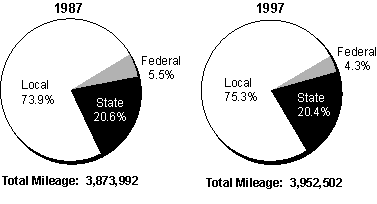U.S. Department of Transportation
Federal Highway Administration
1200 New Jersey Avenue, SE
Washington, DC 20590
202-366-4000
| Conditions and Performance Report Chapter 2—System and Use Characteristics |
| Conditions and Performance Chapter Listing Conditions and Performance Home Page Highway and Bridge System and Use Characteristics Transit System Characteristics
|
|
| Q What constitutes highway jurisdiction? |
| A Jurisdiction refers to governmental ownership, not necessarily responsibility. For example, some roads owned by the Federal Government are maintained by State highway authorities. Additionally, the designation of a public road as a Federal-aid highway does not alter its ownership or jurisdiction as a State or local road—only that its service value and importance have made that road eligible for Federal-aid construction and rehabilitation funds. |
Roads are commonly classified in one of two ways: by ownership or by purpose. This section describes highway and bridge system characteristics with this distinction. Jurisdictional responsibility refers to ownership of a particular road, while functional classification identifies the road by the level of service it provides. For example, arterial highways generally serve long trips; collectors disperse traffic between the arterials and lower level roads; and local roads connect neighborhoods and businesses at the most elementary level. Although this chapter presents highway miles by jurisdiction, system and use characteristics are examined by Highway Functional Classification.
Ownership is divided among the Federal, State, and local governments. States own over 20 percent of the national road network. The Federal Government has responsibility for about 5 percent, primarily in national parks, forests, and Indian reservations. Over 75 percent of the road system is locally controlled, although some intergovernmental agreements may authorize States to construct and maintain locally controlled highways.
As Exhibit 2-2 demonstrates, the share of locally owned routes has grown steadily over the past decade. Public road mileage controlled by local governments increased by 1.4 percent between 1987 and 1997, or an average annual change of 0.2 percent. At the same time, State ownership of public road mileage declined slightly, by 0.2 percent annually, while miles of Federally owned roads declined by about 2.3 percent annually. The decline in Federal ownership of public roads is largely a result of Federal agencies reclassification of some of their mileage from public road to non-public road status.
| Exhibit 2-2 |
| Highway Mileage by Owner, 1987 and 1997 |
 |
Another noticeable trend is the increase in urban highway miles. As urban areas grow throughout the United States, FHWA has expanded Federal-aid urban and urbanized area boundaries. This has led to a sharp decrease in rural miles, which dropped by an average of 0.2 percent annually between 1987 and 1997. During that same period, urban highway miles grew by an average of 1.7 percent each year.
Exhibit 2-3. Highway Mileage by Owner, Selected Years 1987-1997